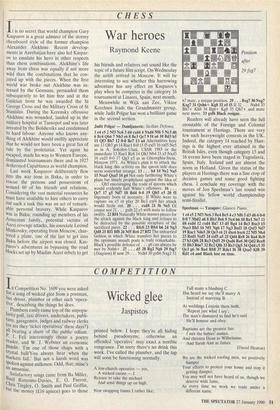CHESS
War heroes
Raymond Keene
It is no secret that world champion Gary Kasparov is a great admirer of the stormy chessboard style of the former champion Alexander Alekhine. Recent develop- ments in Azerbaijan have also led Kaspar- ov to emulate his hero in other respects than chess combinations. Alekhine's life away from chess was equally if not more wild than the combinations that he con- jured up with the pieces. When the first world war broke out Alekhine was in- terned by the Germans, persuaded them subsequently to let him free and at the Galician front he was awarded the St George Cross and the Military Cross of St Stanislay. During the Kerensky offensive Alekhine was wounded, landed up in the military hospital at Tarnopol and was later arrested by the Bolsheviks and condemned to hard labour. Anyone who knows any- thing of Alekhine would swiftly appreciate that he would not have been a great fan of rule by the proletariat. Yet again he escaped, made his way to Western Europe, dominated tournaments there and in 1927 dethroned Capablanca as world champion.
Last week Kasparov deliberately flew into the war zone in Baku, in order to rescue the persons and possessions of around 60 of his friends and relations. Considering the vast material resources he must have available to hire others to carry out such a task this was an act of remark- able personal bravery. While Kasparov Was in Baku, rounding up members of his Armenian family, potential victims of Azeri revenge attacks, his associate Leonid Minkovsky, operating from Moscow, char- tered a plane, one of the last to get into Baku before the airport was closed. Kas- Parov's adventures in bypassing the road blocks set up by Muslim Azeri rebels to get his friends and relatives out sound like the topic of a future film script. On Wednesday the airlift arrived in Moscow. It will be interesting to see whether this harrowing adventure has any effect on Kasparov's play when he competes in the category 16 tournament at Linares, Spain, next month.
Meanwhile in Wijk aan Zee, Viktor Korchnoi leads the Grandmaster group, while Judit Polgar has won a brilliant game in the second section.
Judit Polgar — Damljanovic: Sicilian Defence.
1 e4 c5 2 Nf3 Nc6 3 d4 cxd4 4 Nxd4 Nf6 5 Nc3 d6 6 Bc4 Qb6 7 Nb3 e6 8 Be3 Qc7 9 f4 a6 10 Bd3 b5 11 Qf3 Bbl 12 0-0 Bel 13 a4 Alternatives here are 13 Qh3 g6 14 Rael 0-0 15 f5 exf5 16 exf5 Ne5 as in A. Sokolov-Utasi, USSR 1983 or the immediate 13 Rael Rc8 14 Qh3 Nb4 15 a3 Nxd3 16 cxd3 0-0 17 Qg3 e5 as in Gheorghiu-Stein, Moscow 1971. As White's plan is to attack the bltick king this activity on the queen side does seem somewhat strange. 13 . . . b4 14 Ne2 Na5 15 NxaS Qxa5 16 g4 Not only furthering White's plans but timely prophylaxis against the idea of . . Qh5 encouraging the trade of queens which would evidently halt White's offensive. 16 . . Qc7 17 g5 Nd7 18 Bd4 0-0 19 Qh5 e5 20 f5 Ingenuity born of necessity. If White were to capture on e5 or play 20 Be3 exf4 her attack would fizzle out. 20 . . exd4 21 f6 Ne5 Of course not 21 . . . gxf6 22 e5 with mate to follow swiftly. 22 Rf4 Naturally White masses pieces for the attack against the black king and refuses to be distracted by the possible recapture of the sacrificed piece. 22 . . . RfeS 23 Rh4 h6 24 Ng3 Qd8 25 Rfl Bf8 26 Nf5 Re6 27 Rf2 The unhurried fashion in which White transfers her pieces to the optimum assault posts is truly remarkable. Black's possible defence of . . . g6 can always he met by Nxh6+. 27 . . . d5 28 Rg2 Ng6 29 fxg7 (Diagram) If now 29 • . . Nxh4 30 gxh6 Nxg2 31 Position after 29 fxg7
h7 mate, a unique position. 29 . . . Bxg7 30 Nxg7 Kxg7 31 Qxh6+ Kg8 32 e5 f5 If 32 . . . Nxh4 33 Bh7+ Kh8 34 Bg6+ Kg8 35 Qh7+ and mate next move. 33 gxf6 Black resigns.
Readers will already have seen the full crosstable of the Foreign and Colonial tournament at Hastings. There are very few such heavyweight contests in the UK. Indeed, the category 14 reached by Hast- ings is the highest ever attained in the British Isles, even though category 15 and 16 events have been staged in Yugoslavia, Spain, Italy, Iceland and are almost the norm in Holland. Given the status 'of the players at Hastings there was a fine crop of decisive games and some good fighting chess. I conclude my coverage with the moves of Jon Speelman's last round win against his fellow world championship semi-finalist.
Speelman — Yusupov: Giuoco Piano.
1 e4 e5 2 Nf3 Nc6 3 Bc4 Bc5 4 c3 Nf6 5 d3 d6 6 0-0 0-0 7 Nbd2 a6 8 Bb3 Be6 9 Nc4 h6 10 Rel Ne7 11 d4 exd4 12 cxd4 Ba7 13 d5 Bg4 14 Be3 Bxe3 15 Nxe3 Bh5 16 Nfl Ng6 17 Ng3 Bxf3 18 Qxf3 Nd7 19 Racl NdeS 20 Qe3 c6 21 dxc6 bxc6 22 Nf5 Nh4 23 Redl NxfS 24 exf5 a5 25 Qd4 Re8 26 Ba4 Rc8 27 h3 Qf6 28 Rc3 QxfS 29 Qxd6 Re6 30 Qd2 Rce8 31 Bb3 R6e7 32 Bc2 Qf6 33 Re3 Qg5 34 Qd4 c5 35 Qc3 g6 36 Ba4 Rb8 37 Rdel f6 38 QxaS Kfl 39 Rdl c4 and Black lost on time.


























































 Previous page
Previous page